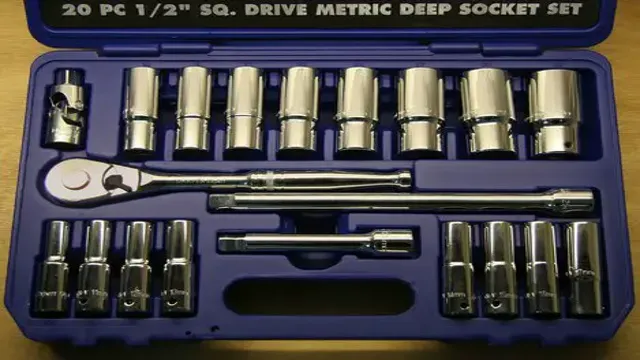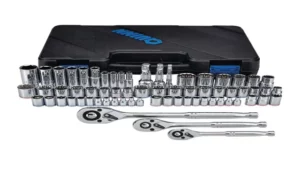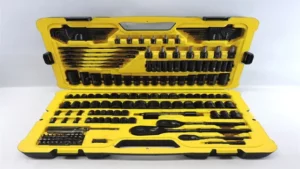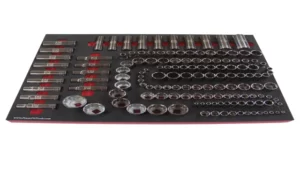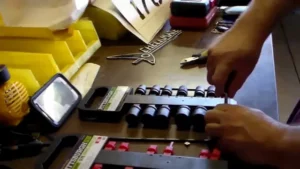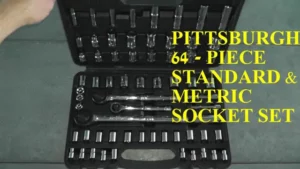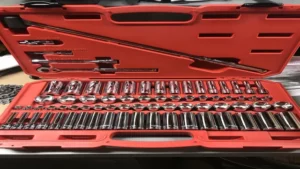Maintaining your vehicle is essential for its longevity, and that means having the right tools to get the job done correctly. One of the most crucial tools you’ll need is a socket set. However, with so many socket sizes to choose from, it can be challenging to know which one you need.
After all, the last thing you want to do is buy a socket set and find out it’s not the right size for the job and be left stuck with a broken vehicle. So, how do you know which socket size to use for car maintenance? In this blog post, we’ll explore the different socket sizes available and give you tips for choosing the right one for your next maintenance project.
Understanding Socket Sizes
When it comes to car maintenance, the size of socket set you need will depend on the type of bolt or nut you are working with. The three main socket sizes you’ll encounter are 1/4-inch, 3/8-inch, and 1/2-inch drive. For general maintenance and repairs, a 3/8-inch drive socket set is usually sufficient.
This size can handle most nuts and bolts on a car, including the spark plugs, brake calipers, and suspension components. However, if you plan on tackling more heavy-duty repairs, you may want to invest in a 1/2-inch drive set, which can handle larger, tougher bolts. On the other hand, a 1/4-inch drive set is great for smaller, more delicate jobs such as working on electronics and adjusting carburetors.
Ultimately, the size of socket set you need will depend on your specific needs and the type of repairs you plan on tackling.
Metric vs. Standard Measurements
When it comes to socket sizes, it can sometimes be confusing to figure out which one is right for the job. One factor to consider is whether you are using metric or standard measurements. Metric measurements are based on the International System of Units (SI) and use millimeters (mm) to measure distance.
Standard measurements, on the other hand, use inches (in) and fractions of an inch. It’s important to choose the correct measurement system for your sockets, as using the wrong one could result in improper fit and potential damage to your tools. One way to remember which system you need is to think about where your tools were made.
If they were made in the United States, chances are you will need standard measurements. If they were made outside of the US, they likely use metric measurements. Taking the time to understand the differences between metric and standard measurements can save you a lot of frustration down the road.
So next time you’re selecting a socket size, remember to check whether you need metric or standard measurements.
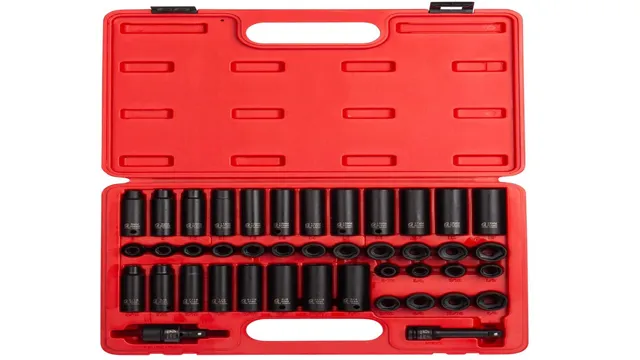
Common Socket Sizes for Car Maintenance
Socket sizes are an essential aspect of car maintenance tasks that you need to understand to ensure you have the right tool for the job. Whether you’re an experienced mechanic or a DIY enthusiast, it’s crucial to have a diverse range of socket sizes in your toolbox. The most common socket sizes for car maintenance include ¼ inch, 3/8 inch, and ½ inch sockets.
The ¼ inch socket is ideal for light jobs such as removing a battery clamp or changing spark plugs, while 3/8 inch sockets are perfect for medium-duty tasks such as removing brake calipers. For more challenging jobs like suspension work, the ½ inch socket is the right tool for the job. Understanding socket sizes can help you tackle various car maintenance tasks quickly and efficiently.
Factors to Consider When Choosing Socket Size
When it comes to car maintenance, having the right size socket set can make all the difference. There are several factors to consider when choosing what size socket set to use, including the size of the bolts or nuts you’ll be working with. It’s essential to have sockets that fit snugly onto the fasteners to avoid slipping or stripping them.
Another factor to consider is the type of drive size compatible with your car, often either 1/4-inch, 3/8-inch, or 1/2-inch. Generally, a set with a broad range of socket sizes is ideal, as it can cover most of your car maintenance needs, making repairs much more accessible, and reducing the risk of damaging bolts or nuts. Ideally, a 3/8-inch drive socket set with a selection of deep and shallow sockets ranging from 6mm to 24mm should suffice for most car maintenance tasks.
By considering the factors mentioned above and investing in the right size socket set, you can make your car maintenance tasks a breeze.
Type of Work Being Done
When it comes to choosing the right socket size for a job, there are several factors that must be taken into consideration. One of the most important things to think about is the type of work that is being done. For example, if you’re working on a project that requires a lot of torque, then you’ll want to choose a socket size that is larger and more heavy-duty.
On the other hand, if you’re working on a job that requires a lot of precision and delicacy, then a smaller socket size may be more appropriate. Additionally, the shape of the socket and the type of fastener being used can also affect the socket size that you need. So, before you start any project, it’s important to take a close look at the requirements of the job and choose the right socket size accordingly.
By doing so, you can ensure that you get the job done efficiently and effectively, without any unnecessary complications or mishaps.
Vehicle Make and Model
When it comes to choosing the right socket size for your vehicle, there are several important factors to consider. First and foremost, you’ll want to take into account the make and model of your car or truck. Different vehicles require different socket sizes, and using the wrong size can lead to damage or stripped bolts.
You can usually find information about which socket size to use in your vehicle’s owner manual or through an online search. Another important factor to consider is the type of repairs or maintenance you’ll be performing. For example, if you’ll be working on the engine or suspension, you may need a larger socket size than if you’re just changing a tire.
Also, make sure to consider the quality of the socket you choose. Cheaper, low-quality sockets may wear down or break more easily, leading to further damage. In short, taking the time to choose the right socket size for your vehicle and specific repairs will help ensure a safe and effective repair job.
Manufacturer Recommendations
When it comes to choosing the right socket size for your work, it’s important to consider the manufacturer recommendations. These recommendations are based on the type of work you’ll be doing, the size of the bolts or nuts you’ll be working with, and the torque specifications needed to ensure proper tightening. Choosing the wrong socket size can result in stripped bolts, damaged tools, and even injury.
You should also consider the material of the socket and how it will hold up under the conditions of your work environment. Keep in mind that a bigger socket may seem like a good idea, but it can actually damage smaller bolts or nuts if not used correctly. Ultimately, following the manufacturer recommendations and using the appropriate socket size will ensure a safe and efficient work experience.
Benefits of Using the Right Socket Size
When it comes to car maintenance, choosing the right socket size is essential for ensuring a successful repair or maintenance task. The size of your socket set has a significant impact on the efficiency of your work, making the process smoother and faster. The most commonly used socket size for car maintenance is the 3/8-inch drive, while the larger 1/2-inch drive sockets are handy for removing rusty or stubborn parts.
Not only does using the correct size socket prevent damage to your tools and the workpiece, but it also prevents injuries and fatigue caused by struggling to accomplish a task with the wrong size. Choosing the right size socket also helps save time and improve efficiency by allowing you to complete a task quickly and avoid unnecessary adjustments or damages. Therefore, a well-equipped socket set with various sizes can help you complete many auto repairs and maintenance tasks with ease.
Avoiding Damage to Nuts and Bolts
When it comes to working with nuts and bolts, using the right socket size can make all the difference. Not only can it make the job easier, but it can also prevent damage to the hardware you’re working with. Using a socket that’s too small can cause damage to the corners of the bolt or nut, making it difficult to remove or even causing it to become stripped.
On the other hand, using a socket that’s too large can lead to the same result, especially if it causes the socket to slip. That’s why it’s so important to choose the right size for your job. Not only will it make things go smoother, but it can also save you from costly mistakes down the line.
So next time you’re working on a project, be sure to double-check that you’ve got the right socket size for the job at hand.
Preventing Injury or Accidents
Using the right socket size can have multiple benefits, one of which is preventing injuries or accidents. When you use the wrong size socket, it can slip off the nut or bolt head, causing your hand to slip and potentially leading to a hand injury. Furthermore, using the wrong size socket can place unnecessary strain on the tool or power tool being used, leading to damage or malfunctioning.
By using the correct socket size, you can complete your project smoothly and efficiently without having to worry about any potential injury or accidents. So next time you’re working on a project, take the time to double-check that you have the right size socket to avoid any mishaps and keep yourself safe.
Final Thoughts
When it comes to car maintenance, having the right tools is essential to get the job done efficiently and effectively. One of the most important toolsets to have on hand is a socket set, which can make loosening and tightening bolts a breeze. But what size socket set do you need for car maintenance? Well, it really depends on the make and model of your car and the types of repairs you’ll be doing.
Generally, a 3/8 inch socket set with sizes ranging from 8mm to 19mm will cover most basic car maintenance tasks. However, if you have a larger vehicle or plan on doing more advanced repairs, you may also need a 1/2 inch socket set with larger sizes. It’s always a good idea to research the specific needs of your car and consult with a professional mechanic before making any investments in tools.
Conclusion
In conclusion, the size of your socket set for car maintenance depends on the types of nuts and bolts you’ll encounter under the hood. It’s like choosing the right outfit for the occasion – a fancy occasion warrants a sleek designer dress, just as a larger car with various nuts and bolts requires a larger socket set. So, next time you’re preparing for a maintenance job, remember that the right socket set is key to a successful DIY repair.
Happy wrenching!”
FAQs
1. What are the common socket sizes needed for car maintenance? A: The most common socket sizes needed for car maintenance are 1/4 inch, 3/8 inch, and 1/2 inch. 2. How many sockets should I have in my car maintenance set? A: It is recommended to have at least a 40-piece socket set for basic car maintenance, but the number of sockets needed can vary depending on the specific repairs. 3. Can I use a regular socket set for car maintenance? A: While some sockets in a regular set may work for car maintenance, it is best to use a specialized socket set that includes the most commonly used sizes for cars. 4. What is the best socket set for car maintenance for beginners? A: A basic 40-piece socket set with 1/4 inch, 3/8 inch, and 1/2 inch sizes is a good starter set for car maintenance beginners. 5. Is it necessary to have a deep socket set for car maintenance? A: Having a deep socket set can be helpful for certain car repairs, but it is not always necessary for basic car maintenance. 6. What should I look for when buying a socket set for car maintenance? A: When buying a socket set for car maintenance, look for a set with a variety of sizes, durability, and compatibility with your car’s make and model. 7. Should I invest in a high-quality socket set for car maintenance? A: Yes, investing in a high-quality socket set can save you money in the long run by preventing damage to your car and allowing for more efficient repairs.
